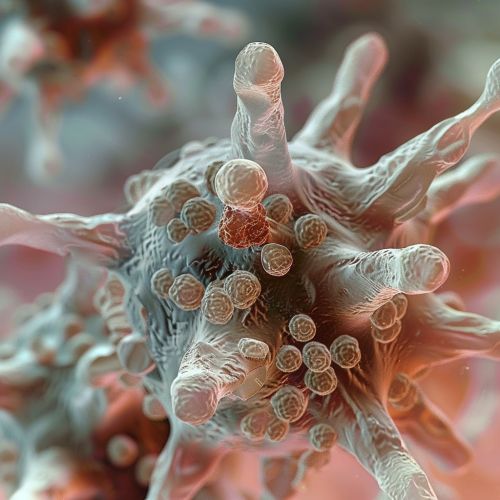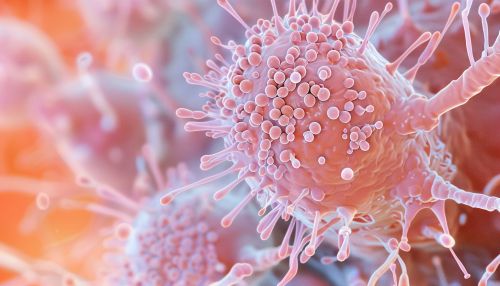Mast cell
Introduction
A Mast cell is a type of white blood cell that plays a crucial role in the body's immune response. They are part of the myeloid lineage and are most commonly associated with allergic reactions. However, their role extends beyond this, as they are also involved in wound healing, angiogenesis, immune tolerance, defense against pathogens, and blood-brain barrier function.
Structure
Mast cells are relatively large in size and are characterized by their cytoplasm filled with granules. These granules contain various chemical mediators such as histamine, heparin, serotonin, and various enzymes. The cell's nucleus is small and often partially obscured by the granules. Mast cells express a high-affinity receptor (FcεRI) for the Fc region of IgE, a type of antibody. This characteristic is used by the immune system to 'arm' mast cells with IgE, which is produced in response to allergens.


Development and Distribution
Mast cells are derived from hematopoietic progenitor cells in the bone marrow. These progenitor cells migrate through the blood to various tissues in the body, where they mature into mast cells. The process of mast cell maturation is influenced by various factors, including cytokines and the local tissue environment. Mast cells are widely distributed throughout the body, particularly in tissues that interface with the external environment, such as the skin, lungs, and gastrointestinal tract. They are also found in connective tissues, the cardiovascular system, and the nervous system.
Function
The primary function of mast cells is to mediate immune responses, particularly those associated with allergy and asthma. When an allergen binds to the IgE antibodies that are bound to the mast cell, it triggers a process called degranulation, where the mast cell releases its granules into the surrounding tissue. These granules contain a variety of chemical mediators that cause the symptoms associated with allergic reactions.
Mast cells also play a role in the defense against pathogens. They have receptors that can recognize bacterial and viral patterns, and upon activation, they can release a variety of inflammatory mediators that help recruit other immune cells to the site of infection.
In addition to their role in immunity, mast cells also contribute to wound healing and tissue repair. They can release growth factors and angiogenic factors that promote cell proliferation and blood vessel formation.
Clinical Significance
Mast cells play a central role in many allergic diseases, including asthma, allergic rhinitis, and anaphylaxis. In these conditions, the inappropriate activation of mast cells leads to excessive inflammation and tissue damage.
Mast cells are also involved in a number of other diseases, including mastocytosis, a condition characterized by an excessive number of mast cells, and mast cell activation syndrome, a condition in which the mast cells are overly reactive.
In recent years, the role of mast cells in cancer has been increasingly recognized. In some types of cancer, mast cells appear to promote tumor growth, while in others they seem to have a protective effect.
